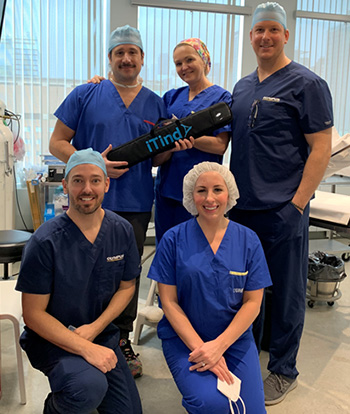First BPH Treatment Procedures Performed in Canada with Minimally Invasive iTind Device

Dr. Dean Elterman, back left, has performed the first iTind procedures in Canada.
CENTER VALLEY, Pa. (June 23, 2022) - Olympus, a global technology leader in designing and delivering innovative medical technology solutions, announced today the first commercial treatment of Benign Prostatic Hyperplasia (BPH) in Canada using the minimally invasive iTind™ procedure.
Dr. Dean Elterman, a urologist at University Urology Associates and a faculty member in the University of Toronto's Division of Urology, is the first physician in Canada to perform the iTind procedure to treat BPH, also known as an enlarged prostate.
BPH is a common problem as it will affect 50% of men between the ages of 51 and 60 and up to 90% of men over the age of 80.1 The minimally invasive iTind procedure offers a treatment option beyond medication, surgery or permanent implants.
"Too often, men will stay silent about the symptoms they are experiencing from an enlarged prostate that hamper their day-to-day lives, such as the urgent need to urinate or sleepless nights because they are frequently waking up to pee," Dr. Elterman said. "I'm thrilled to offer patients the option of the minimally invasive, relatively low-risk iTind procedure that can be performed in an office setting and provide quick and effective relief from symptoms."
Dr. Elterman is a paid consultant for Olympus.
Mario Elia, 69, said he'd experienced a weakened urine stream since his 40s due to what physicians deemed a "lazy urethra." Mario, who lives in Toronto, said for years it was little more than a nuisance he learned to live with, and that he became accustomed to waking up once or twice a night to use the bathroom.
"But when it got to the point where it became three, four, even five times a night that became a catalyst for me to look for treatment options," Mario said, adding that the urgency to go also became more pronounced.
After trying two rounds of prescription medications, the results of which he ultimately found unsatisfactory, Mario said his research into BPH therapy eventually led him to the iTind procedure. He said that he was immediately interested given the minimally invasive nature of the procedure and the prospect of not needing a catheter following treatment.
Mario described his procedures to insert and remove the iTind device as simple and relatively quick with minimal discomfort. In the weeks following the procedure, he reported an improved urine stream and more restful nights. As with all medical procedures, results may vary. The statements of Mario's are his own and should not be used as advice given by a physician.
"I'm getting up once a night, that's a victory," Mario said.
Treatment with the iTind procedure takes a week and works by gently reshaping the prostate. The device's three nitinol (nickel titanium alloy) struts gradually expand while the temporary implant is in place, creating channels through which urine can flow. Once the device is removed, most men go home without the need of a catheter, and the procedure does not limit patients to any future treatment options.
Placement and retrieval can be done in a hospital, ambulatory surgery center, or medical office setting, and this flexibility in the site of care means the iTind procedure can be offered by physicians almost anywhere, including smaller, rural facilities.
The iTind procedure is indicated for men 50 years and older and does come with the possibility of side effects, including pelvic discomfort, blood in the urine and painful or urgent urination. In rare cases, the device may cause urinary tract infection or a sudden difficulty to urinate.
For more information about the iTind procedure, visit https://bphtherapy.com/itind.
###
About Olympus
Olympus is passionate about creating customer-driven solutions for the medical industry. For more than 100 years, Olympus has focused on making people's lives healthier, safer and more fulfilling by helping to detect, prevent, and treat disease; and furthering scientific research.
As a leading medical technology company, Olympus uses innovative capabilities in medical technology, therapeutic intervention, and precision manufacturing to help healthcare professionals deliver diagnostic, therapeutic, and minimally invasive procedures to improve clinical outcomes, reduce overall costs, and enhance the quality of life for patients and their safety. Olympus' Medical portfolio includes endoscopes, laparoscopes, and video imaging systems, as well as surgical energy devices, system integration solutions, medical services, and a wide range of endotherapy instruments for endoscopic and therapeutic applications. For more information, visit https://medical.olympusamerica.com.
- American Urological Association, Urologyhealth.org, "Urology A-Z: Benign Prostatic Hyperplasia." Updated Sept. 2021, Accessed April 13, 2022


































